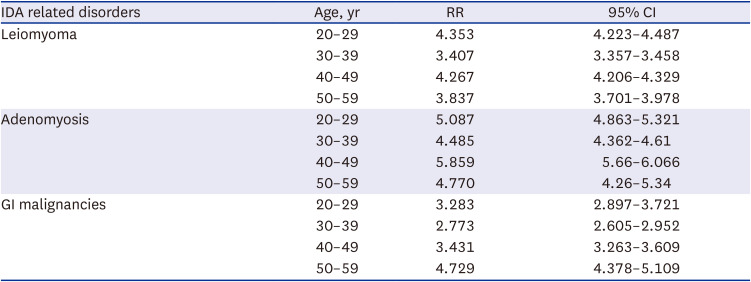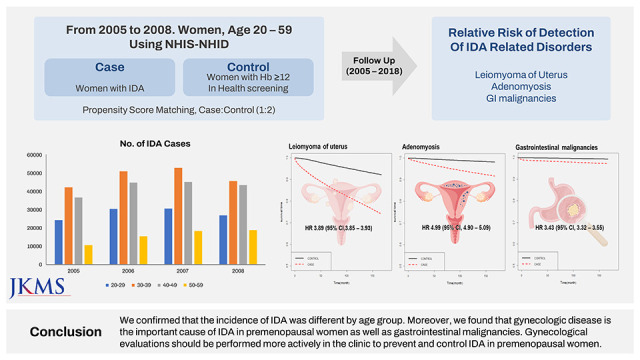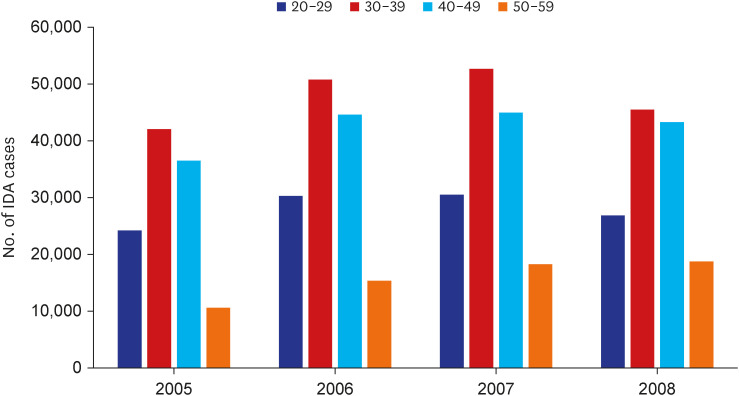1. Kassebaum NJ, Jasrasaria R, Naghavi M, Wulf SK, Johns N, Lozano R, et al. A systematic analysis of global anemia burden from 1990 to 2010. Blood. 2014; 123(5):615–624. PMID:
24297872.

2. Allen LH. Anemia and iron deficiency: effects on pregnancy outcome. Am J Clin Nutr. 2000; 71(5):Suppl. 1280S–1280S. PMID:
10799402.

3. Carter RC, Jacobson JL, Burden MJ, Armony-Sivan R, Dodge NC, Angelilli ML, et al. Iron deficiency anemia and cognitive function in infancy. Pediatrics. 2010; 126(2):e427–e434. PMID:
20660551.

4. Eisenstaedt R, Penninx BW, Woodman RC. Anemia in the elderly: current understanding and emerging concepts. Blood Rev. 2006; 20(4):213–226. PMID:
16472893.

5. Haas JD, Brownlie T 4th. Iron deficiency and reduced work capacity: a critical review of the research to determine a causal relationship. J Nutr. 2001; 131(2):2S-2. 676S–88S. PMID:
11160598.

6. World Health Organization. The World Health Report 2002: Reducing Risks, Promoting Healthy Life. Geneva, Switzerland: World Health Organization;2002.
7. World Health Organization. Worldwide Prevalence of Anaemia 1993–2005: WHO Global Database on Anaemia. Geneva, Switzerland: World Health Organization;2008.
8. Stevens GA, Finucane MM, De-Regil LM, Paciorek CJ, Flaxman SR, Branca F, et al. Global, regional, and national trends in haemoglobin concentration and prevalence of total and severe anaemia in children and pregnant and non-pregnant women for 1995-2011: a systematic analysis of population-representative data. Lancet Glob Health. 2013; 1(1):e16–e25. PMID:
25103581.

9. Camaschella C. Iron-deficiency anemia. N Engl J Med. 2015; 373(5):485–486.

11. Lee JO, Lee JH, Ahn S, Kim JW, Chang H, Kim YJ, et al. Prevalence and risk factors for iron deficiency anemia in the Korean population: results of the fifth Korea National Health and Nutrition Examination Survey. J Korean Med Sci. 2014; 29(2):224–229. PMID:
24550649.

12. Breymann C, Auerbach M. Iron deficiency in gynecology and obstetrics: clinical implications and management. Hematology Am Soc Hematol Educ Program. 2017; 2017(1):152–159. PMID:
29222250.

13. Kepczyk T, Cremins JE, Long BD, Bachinski MB, Smith LR, McNally PR. A prospective, multidisciplinary evaluation of premenopausal women with iron-deficiency anemia. Am J Gastroenterol. 1999; 94(1):109–115. PMID:
9934740.

14. Kasper DL. Harrison’s Principles of Internal Medicine. 19th ed. New York, NY, USA: McGraw Hill Education Medical;2015.
15. Cheol Seong S, Kim YY, Khang YH, Heon Park J, Kang HJ, Lee H, et al. Data resource profile: The National Health Information Database of the National Health Insurance Service in South Korea. Int J Epidemiol. 2017; 46(3):799–800. PMID:
27794523.

18. Sparic R, Mirkovic L, Malvasi A, Tinelli A. Epidemiology of uterine myomas: a review. Int J Fertil Steril. 2016; 9(4):424–435. PMID:
26985330.
19. Garcia L, Isaacson K. Adenomyosis: review of the literature. J Minim Invasive Gynecol. 2011; 18(4):428–437. PMID:
21622029.

20. Lee M, Chung YJ, Kim HK, Hwang H, Park JY, Shin I, et al. Estimated prevalence and incidence of uterine leiomyoma, and its treatment trend in South Korean Women for 12 years: a national population-based study. J Womens Health (Larchmt). 2021; 30(7):1038–1046. PMID:
32991229.

21. Choi EJ, Cho SB, Lee SR, Lim YM, Jeong K, Moon HS, et al. Comorbidity of gynecological and non-gynecological diseases with adenomyosis and endometriosis. Obstet Gynecol Sci. 2017; 60(6):579–586. PMID:
29184867.

22. Kim JW, Kim SH, Kang JK. A study on the relationship between attitude to sex and prevention efforts against cervical cancer among Korean women in their 20s. J Korean Soc Sch Community Health Educ. 2021; 22(2):15–23.

23. Choi WM, Han NK, Chung W. Factors associated with the non-screening status of cervical cancer screening test in Korean adult women: Korea National Health and Nutrition Examination Survey (2010–2012). Health Policy Manag. 2019; 29(4):399–411.
24. Clancy KB, Nenko I, Jasienska G. Menstruation does not cause anemia: endometrial thickness correlates positively with erythrocyte count and hemoglobin concentration in premenopausal women. Am J Hum Biol. 2006; 18(5):710–713. PMID:
16917885.

25. Kang MJ, Won YJ, Lee JJ, Jung KW, Kim HJ, Kong HJ, et al. Cancer statistics in Korea: incidence, mortality, survival, and prevalence in 2019. Cancer Res Treat. 2022; 54(2):330–344. PMID:
35313102.

26. Kim SJ, Ha SY, Choi BM, Lee MY, Jin JY, Yeom SJ, et al. The prevalence and clinical characteristics of cancer among anemia patients treated at an outpatient clinic. Blood Res. 2013; 48(1):46–50. PMID:
23589795.










 PDF
PDF Citation
Citation Print
Print






 XML Download
XML Download